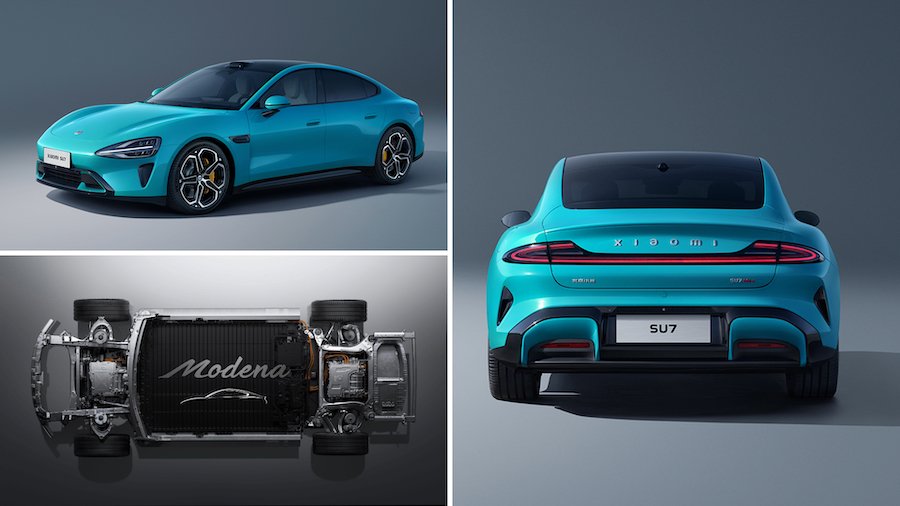Xiaomi Drops SU7 Bomb, Targets 500 Miles of Range and Plaid-Level Performance

With modern electric vehicles being essentially computers on wheels, it was only a matter of time until an IT company built a compelling EV. Many technology companies, including Sony and Apple, have started working on their car projects, but none moved as fast as Xiaomi, one of the global smartphone market leaders. Xiaomi officially admitted it was working on an electric vehicle in March 2021, one month after the first rumors surfaced. Now, the technology giant unveiled its first model, the SU7 electric sedan.
It's laughable that some refer to Xiaomi's car project as an "Apple Car rival" when there's no such thing as an Apple Car. As one who switched to an iPhone after spending the past seven years using Xiaomi smartphones, I hope the fruit-themed company never attempts to launch a car. Software-defined vehicles nowadays require much more than cosmeticizing the same old software, as Apple has complacently done since the original iPhone. Xiaomi may have started as an Apple rip-off phone maker, but it wasn't shy about innovating the smartphone in ways Apple stopped doing long ago.
While Xiaomi may be criticized for not innovating anything in the EV arena, the Chinese company at least got all the basics right. It's easy to guess which company it copied this time, and it sure wasn't Apple. Its first model, the SU7 sedan, looks like a more streamlined Tesla Model S, with some Porsche Taycan hints here and there. These two models have served as benchmarks for the SU7 not just in the design department but also technology- and performance-wise.
The Xiaomi SU7's design has been supervised by none other than ex-BMW Chris Bangle. Bangle worked with Tianyuan Li, formerly involved with BMW's iX series and iVision concepts, and James Qiu, who had previously worked on Mercedes-Benz's Vision EQXX design. This probably explains the SU7's claimed coefficient of drag, which is 0.195. The SU7 thus beats the Lucid Air, which has a 0.197 drag coefficient, to become the most aerodynamic production car in the world.
The Xiaomi SU7 is based on the company's first EV architecture, dubbed "Modena," with technical details that Tesla would also choose for its most advanced EVs. It features a structural battery pack, which Xiaomi calls "cell-to-body battery," as well as megacastings front and rear, in this case called "hypercastings." Xiaomi uses die-casting machines with a clamping force of 9,100 tons, which suggests the rookie Chinese EV maker still has work to do to improve the alloy composition and the structure design.
Apparently, everything is hyper about the SU7 because its electric motors are named "HyperEngine." Currently, Xiaomi is producing HyperEngine V6/V6s motors, which can get as high as 21,000 rpm, with the HyperEngine V8s variant (27,200 rpm) slated to enter service by 2025. However, Xiaomi is working on an improved HyperEngine motor using a carbon-sleeved rotor, which is able to reach 35,000 rpm. So far, Xiaomi intends to install the HyperEngine V6 in the entry-level SU7 RWD, with a V6/V6s combination reserved for the dual-motor SU7 Max.
The Modena architecture uses an 800-volt high-voltage system for the SU7 Max performance variant. However, it only offers a 400-volt system on the entry-level SU7, which allows Xiaomi to cut costs where it makes sense. Even so, Xiaomi CEO Lei Jun warned that the SU7 won't be cheap, considering all the technology behind it.
The Xiaomi SU7 RWD uses a 74-kWh LFP battery supplied by CATL to power the 220 kW (295 horsepower) electric motor. This allows it to sprint from 0 to 100 kph (62 mph) in 5.3 seconds and travel up to 668 km (415 miles) between charges, according to China's CLTC cycle. The performance variant SU7 Max sports two motors for a total of 495 kW (664 horsepower), which is enough to cut the acceleration time to 2.78 seconds. Performance-wise, the Xiaomi SU7 is slightly ahead of the Porsche Taycan Turbo, which Xiaomi proudly points out.
The SU7 Max also benefits from using more energy-dense battery cells, also supplied by CATL. This time, it's the company's Qilin battery, with a capacity of 101 kWh. This allows the SU7 Max to reach 800 km (500 miles) of range on one charge. Xiaomi claims that the SU7 can recharge 220 km (137 miles) in 5 minutes, 390 km (242 miles) in 10 minutes, and 510 km (317 miles) in 15 minutes of charging.
The Xiaomi SU7 is filled to the brim with technology, with the infotainment system powered by Qualcomm's Snapdragon Automotive platform. The car runs HyperOS, Xiaomi's proprietary operating system, which it says will be open to third parties to enhance the onboard experience by leveraging the Xiaomi CarIOT (Internet of Things) platform.
The car has obviously autonomous driving capabilities, thanks to the Xiaomi Pilot platform powered by Nvidia Orin processors. The sensor suite includes a top-mounted Lidar with a visual range of up to 200 meters and pixel accuracy of down to 0.1 meters. This is backed by radar, ultrasonic sensors, and cameras to offer an accurate image of the car's surroundings and traffic. Xiaomi aims to complete autonomous driving tests in 100 cities across China by the end of 2024.
While the pricing has not been revealed, Xiaomi CEO Lei Jun confirmed that the SU7 will not be cheap. The first vehicles will be delivered "early in 2024," with the state-owned BAIC Group in charge of manufacturing. Xiaomi has big ambitions, as Lei Jun wants to become one of the top 5 car companies in the world in the next 15-20 years.
Related News


